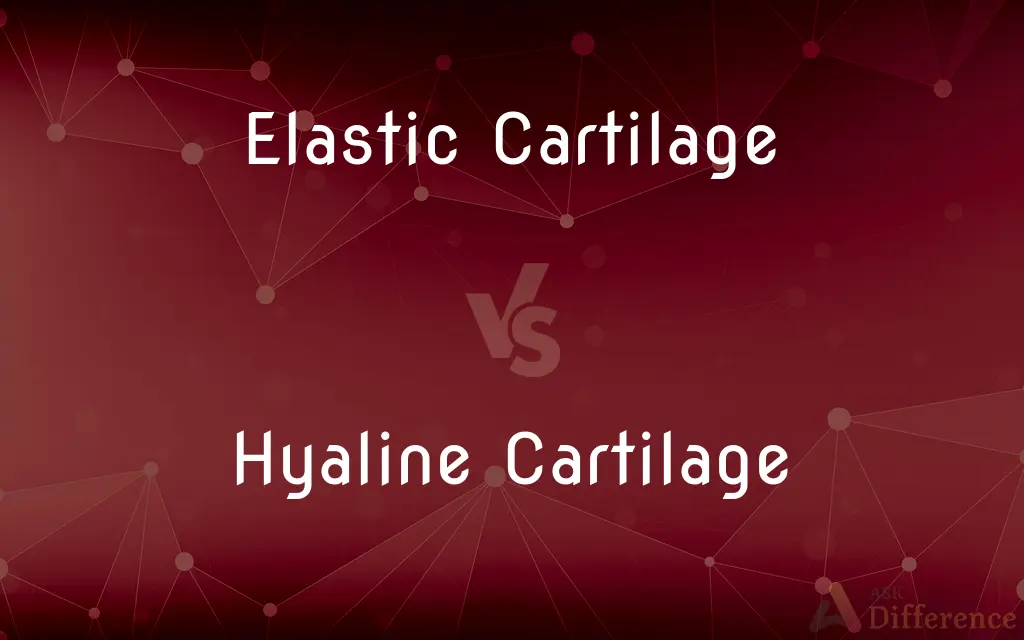Elastic Cartilage vs. Hyaline Cartilage — What's the Difference?
By Tayyaba Rehman & Urooj Arif — Published on March 25, 2024
Elastic cartilage is flexible, containing a dense network of elastin fibers, found in structures like the ear, while hyaline cartilage is more rigid, with a smooth surface, primarily located in joints, the rib cage, and the nose.

Difference Between Elastic Cartilage and Hyaline Cartilage
Table of Contents
ADVERTISEMENT
Key Differences
Elastic cartilage is characterized by its high content of elastic fibers, which provide it with remarkable flexibility and resilience. This type of cartilage is essential for structures that require bending and snapping back to their original shape, such as the external ear (auricle), the epiglottis, and parts of the larynx. Its unique composition allows it to withstand repeated bending and stretching.
Hyaline cartilage, on the other hand, is the most common type of cartilage in the body, known for its stiff yet somewhat flexible support. It contains a much lower proportion of elastic fibers and a higher amount of collagen, giving it a glassy, translucent appearance. Hyaline cartilage is found in areas that require strong support and cushioning, such as the ends of ribs, the nose, and the surfaces of joints (articular cartilage), where it reduces friction and absorbs shock.
The primary functional difference between the two lies in their mechanical properties: elastic cartilage is designed for flexibility and resilience, while hyaline cartilage provides support and cushioning with limited flexibility. These differences reflect their distinct roles in the body, with each type of cartilage located in areas suited to its specific function.
Both types of cartilage are critical for the proper functioning of various body structures, yet they have limited capacity for repair. This limited regenerative ability is due to the avascular nature of cartilage, which means it lacks blood vessels, receiving nutrients through diffusion, which is a slow and inefficient process for healing.
Comparison Chart
Composition
High content of elastic fibers
High content of collagen, lower elastic fibers
ADVERTISEMENT
Location
Ear, epiglottis, larynx
Joints, rib cage, nose
Function
Provides flexibility and shape retention
Offers support and cushioning, reduces friction
Appearance
Yellowish and more opaque
Glassy, translucent
Repair Capacity
Limited, similar to other cartilage types
Limited, due to being avascular
Compare with Definitions
Elastic Cartilage
Essential for the structure and function of certain body parts.
Vocal cords contain elastic cartilage for resilience and durability.
Hyaline Cartilage
Rigid cartilage with a smooth surface, providing support.
The smooth, frictionless movement of knee joints is thanks to hyaline cartilage.
Elastic Cartilage
Appears yellowish and opaque.
Upon examination, the elastic cartilage of the larynx has a distinct color.
Hyaline Cartilage
Features a glassy, translucent appearance.
The clear, glossy look of articular cartilage in joints is characteristic of hyaline cartilage.
Elastic Cartilage
Capable of withstanding repeated bending.
The nose's ability to return to shape after bending is partly due to elastic cartilage.
Hyaline Cartilage
Offers cushioning and reduces friction in joints.
Hyaline cartilage in the nose provides structural integrity and cushioning.
Elastic Cartilage
Flexible cartilage with a dense network of elastin fibers.
The flexibility of the ear is due to its elastic cartilage.
Hyaline Cartilage
Has a limited ability to repair after injury.
Damage to the hyaline cartilage of the knee can lead to joint problems due to its limited healing capacity.
Elastic Cartilage
Found in structures requiring shape retention and flexibility.
Elastic cartilage in the epiglottis helps it function properly during swallowing.
Hyaline Cartilage
Predominant in joints, rib cage, and respiratory tract.
Hyaline cartilage at the ends of ribs facilitates chest expansion.
Common Curiosities
Where is elastic cartilage found in the body?
It's found in the ear, epiglottis, and parts of the larynx, where flexibility is essential.
Can cartilage heal after being damaged?
Both types have limited healing capacity due to their avascular nature, making recovery slow and sometimes incomplete.
What is the main function of hyaline cartilage?
Its main function is to provide support, reduce friction, and absorb shock in joints and other parts of the body.
Why is hyaline cartilage important for joints?
It covers the ends of bones in movable joints, providing a smooth, lubricated surface for low-friction movements.
What are the challenges in repairing cartilage damage?
The main challenge is the cartilage's avascular nature, which limits nutrient supply and thus, the healing process.
What makes elastic cartilage different from hyaline cartilage?
Elastic cartilage contains a high concentration of elastin fibers, making it flexible, while hyaline cartilage is more rigid with a high content of collagen.
How can damage to cartilage affect the body?
Damage can lead to pain, reduced mobility, and conditions like arthritis, especially in joints with hyaline cartilage.
Are there any treatments for damaged cartilage?
Treatments include physical therapy, injections, and surgery, but complete restoration is challenging due to limited regenerative capacity.
What is the significance of the elastic fibers in elastic cartilage?
Elastic fibers give this type of cartilage its ability to flex and return to its original shape, crucial for the functions of the structures it composes.
How does the structure of hyaline cartilage contribute to its function?
Its structure provides a balance of rigidity and flexibility, necessary for supporting body structures and facilitating smooth joint movements.
Share Your Discovery

Previous Comparison
Physiotherapy vs. Massage Therapy
Next Comparison
Sol Solution vs. SuspensionAuthor Spotlight
Written by
Tayyaba RehmanTayyaba Rehman is a distinguished writer, currently serving as a primary contributor to askdifference.com. As a researcher in semantics and etymology, Tayyaba's passion for the complexity of languages and their distinctions has found a perfect home on the platform. Tayyaba delves into the intricacies of language, distinguishing between commonly confused words and phrases, thereby providing clarity for readers worldwide.
Co-written by
Urooj ArifUrooj is a skilled content writer at Ask Difference, known for her exceptional ability to simplify complex topics into engaging and informative content. With a passion for research and a flair for clear, concise writing, she consistently delivers articles that resonate with our diverse audience.
















































